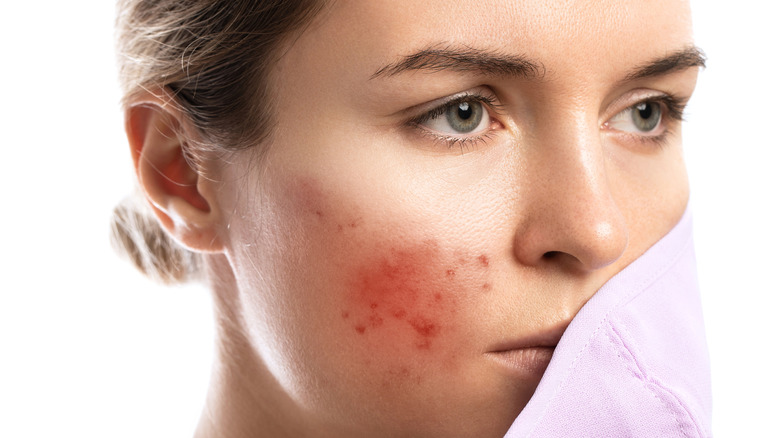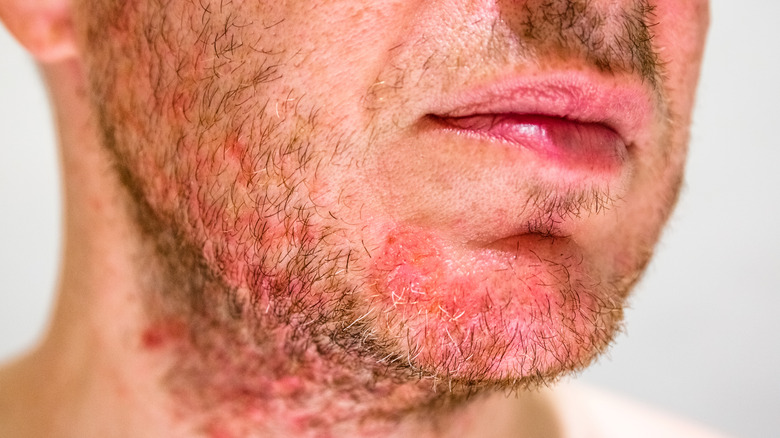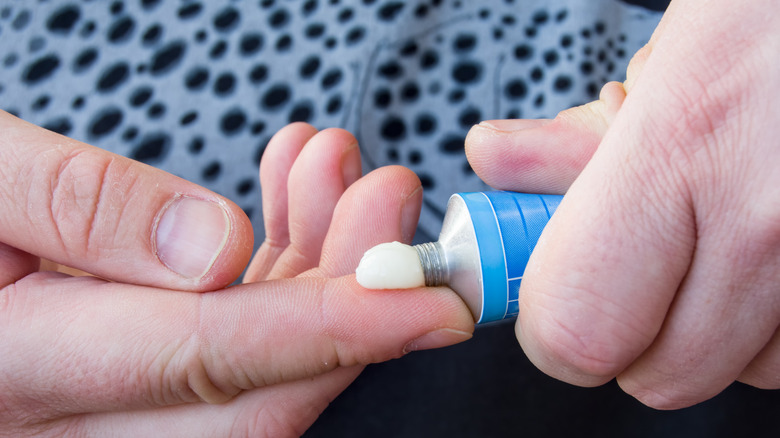How To Get Rid Of Folliculitis?
While most people desire to have clear, beautiful, and healthy-looking skin all the time, they're generally not bothered by a few pimples that pop up on their faces or bodies occasionally. That's because these blemishes tend to disappear after a few days. However, if you are facing acne-like breakouts on any part of your body, you could be suffering from a condition called folliculitis (via American Academy of Dermatology).
According to the Academy, folliculitis is a common skin condition that occurs when the follicles of your hair become infected. Except for the palms of your hands and soles of your feet, which don't have body hair, any part of your body can develop folliculitis.
According to Mayo Clinic, folliculitis appears on your skin because of a fungal or bacterial infection. In the beginning, the breakout may look like small red bumps or pimples with whiteheads. They may cause a lot of itching, too. If your condition worsens, the pimples can develop pus and transform into very painful, nonhealing, crusty sores. If that's your experience, be assured: There is hope.
What causes folliculitis, and what are its types?
According to the American Academy of Dermatology (AAD), your hair follicles can get damaged and infected in a variety of ways, resulting in folliculitis, but there are some common reasons, too. For example, the most common cause of folliculitis is from shaving, waxing, or plucking. Your face, legs, arms, and pubic area are the most susceptible to developing this condition. As Mayo Clinic explains, this type of folliculitis is caused by a bacteria called pseudofolliculitis barbae and it occurs due to the presence of ingrown hairs on your skin. The second type of folliculitis is caused by a bacteria called Staphylococcus aureus (staph). This causes itchy, white, pus-filled bumps on your skin.
You can also develop folliculitis if you use a hot tub. This type of folliculitis is caused by a bacteria called pseudomonas, which is found in many places, including hot tubs and heated pools. It thrives in the water when the chlorine and pH levels are not properly managed (via Mayo Clinic). Other factors that can cause folliculitis include weight gain, wearing tight clothing that can lead to constant chafing, and the use of certain medication.
Lastly, as Mayo Clinic explains, you can get chronic form of folliculitis known as Pityrosporum folliculitis, caused by a yeast infection. As a result, your skin develops pustules on several parts of your body, mainly the back, chest, and sometimes on the neck and shoulders.
How to treat folliculitis
Since folliculitis is a common condition of the skin, you can easily get rid of it. However, it largely depends on the severity of your condition. If your condition has worsened and the pimples are causing pain, or if the infection is not healing even after several weeks, your treatment may take longer (via Medical News Today). If your condition is mild, you can get rid of folliculitis with home remedies, such as warm compresses, soothing baths combined with the use of an oat-meal based product, over-the-counter creams and ointments, and by practicing good hygiene.
If your folliculitis is itchy and persists for a few days, you can ask your medical practitioner or pharmacist to prescribe some antibacterial skin washes and antibiotics — topical and/or oral — to treat the condition (via Medicine Net). If you are suffering from a moderate case of bacterial folliculitis, topical antibiotics, such as clindamycin lotion or metronidazole lotion, can alleviate your condition.
Your doctor may also prescribe you a course of oral antibiotics, such as cephalexin, dicloxacillin, doxycycline, or minocycline. As Medicine Net relates, the treatment can last from five days up to a month, depending on the severity of the condition. As for folliculitis caused by a fungal or yeast infection, you may require an antifungal shampoo, a body wash, and perhaps oral medication. Whatever the case, always consult your healthcare provider before starting any medication to treat your condition.


